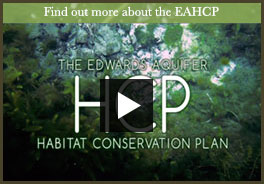Non-Native Species Control
2013 RFP and accepted proposal for Non-native Animal Species Control
Studies have shown that many fishes (especially small fish) have very similar food habitats (Hubbs et al. 1978). If non-native species are added to the aquatic ecosystems, greater competition or overlap among species is possible as these non-native species may be able to acquire resources with greater efficiency than native species (USFWS 1984). Suckermouth catfishes (Loricariidae) are a non-native fish species that has become established in the waters of Texas including San Marcos River (Howells 2005). Suckermouth catfishes prefer to feed on periphyton and algae (Hoover et al. 2006). The fountain darter lays eggs on algae and loss of spawning habitat and possibly egg production are potential threats from suckermouth catfish (SSC 2009). There is some concern that excessive amount of suckermouth catfishes could cause direct (potential displacement) and indirect effect (disruption of food supply) to fountain darter (SSC 2009). Suckermouth catfishes also burrow into the river banks destabilizing them and causing the introduction of additional sediment load into the habitats.
Tilapia is another non-native fish species that can impact fountain darter habitat. Tilapia destroys vegetation by making bare ground nests. During times of low flow and drought this could further reduce already limited habitat for fountain darter. Tilapia is a tropical species that will congregate in winter near spring openings and other warm water resources. When Tilapia congregate this creates the opportunity to use seines, gill nets, cast nets, or methods to remove large quantities with minimal impact to the habitat. Artificial heating could be one method used to congregate fish in areas away from springs and endangered species to minimize the impacts from collection efforts.
A non-native gastropod (giant ramshorn snail [Marisa cornuarietis]) also poses a threat to the San Marcos Springs ecosystem. The giant ramshorn snail, a species in the aquarium trade, was first discovered in Landa Lake in 1984 (McKinney and Sharp 1995). This snail grazes on aquatic plants and in the 1990s played a major role in reducing plant biomass in Landa Lake. This snail prefers clear streams and pools with temperatures of at least 66 degrees F (19 degrees C). When exposed to lower temperatures, the snails withdraw into their shells and only survive for short periods. The warmest temperature that the giant ramshorn snail can withstand is 102 degrees F (39 degrees C). Although the population has diminished since the mid-1990s, the potential for future alteration of plant communities in these two ecosystems remains and could affect endangered species (McKinney and Sharp 1995; BIO-WEST 2007c). The strong preference of fountain darters for aquatic vegetation highlights the concern posed by the grazing activities of the giant ramshorn snail (BIO-WEST 2004a).
To mitigate the impacts of incidental take by pumping and recreational activities, the City of San Marcos, in partnership with Texas State University, will implement non-native and predator species control for the San Marcos River on a periodic basis with expanded effort of control, if needed, at low flows. The species include suckermouth catfish, tilapia, and Melanoides and Marisa snails.
The Pteryogoplichthys disjunctivitis vermiculated (sailfin catfish) adults are concentrated in Spring Lake and Hypostomus plecostomus (suckermouth catfish) are found downstream of Spring Lake. Currently, the most effective method of removal for both species is to hunt with a gig or similar multi-pronged spear. Other technologies, such as the heat box, fish-specific disease, and daughter-less technology require further research for their applicability to these species in the San Marcos River. Additionally, incentives, such as bounty for capture, could be established to encourage fishing for catfish.
With respect to tilapia, the adults are concentrated in the slough arm of Spring Lake. The use of gill nets during their reproductive season (Jan-May) provides an effective method of removal. Using large mesh net along with frequent checks will prevent capture of fountain darters and other desirable species. Additionally, incentives, such as bounty for capture, could be established to encourage fishing for tilapia.
Melanoides snails and the gill parasite (Centrocestus formosanus) have been present in the San Marcos system, but at low levels. Controls will not be implemented initially. However, Melanoides snails and the gill parasite (Centrocestus formosanus) will be monitored and any appropriate measures implemented through the Adaptive Management process. Melanoides tuberculata is located throughout the upper reach of the San Marcos River. If necessary, effective removal can be accomplished by determining the locations of highest snail density and use dip nets to remove the snails weekly.
Marisa cornuarietis is found sporadically in the upper reach of the San Marcos River. This snail vertically migrates at night and is easily spotted with a flashlight. The species will be controlled by diving several hours after sunset to hand-pick the snails from the submergent vegetation.
All personnel implementing any portion of the HCP for the City of San Marcos will undergo an orientation at the NFHTC to ensure awareness of the listed species and safe procedures while working in and along the San Marcos River.
